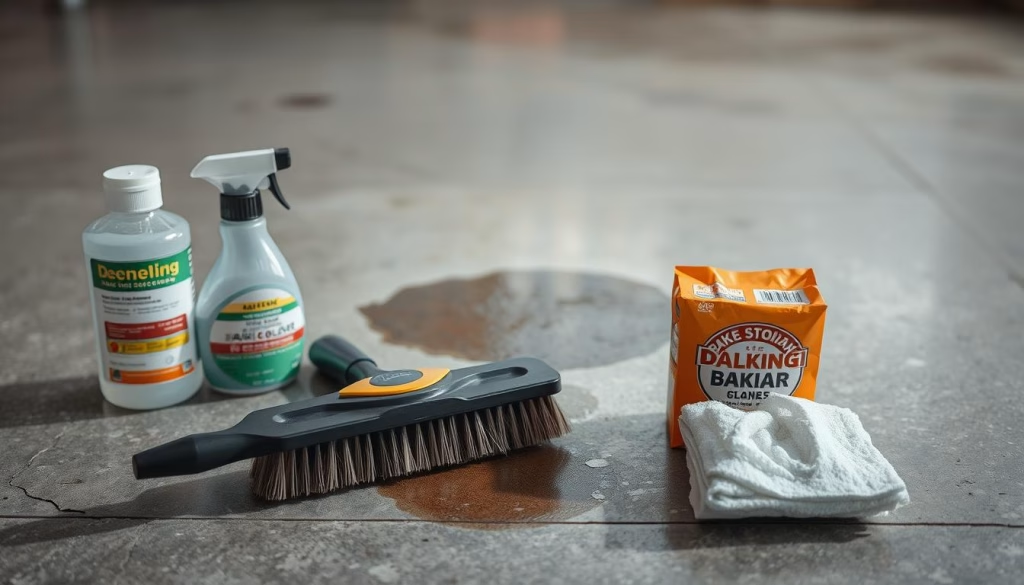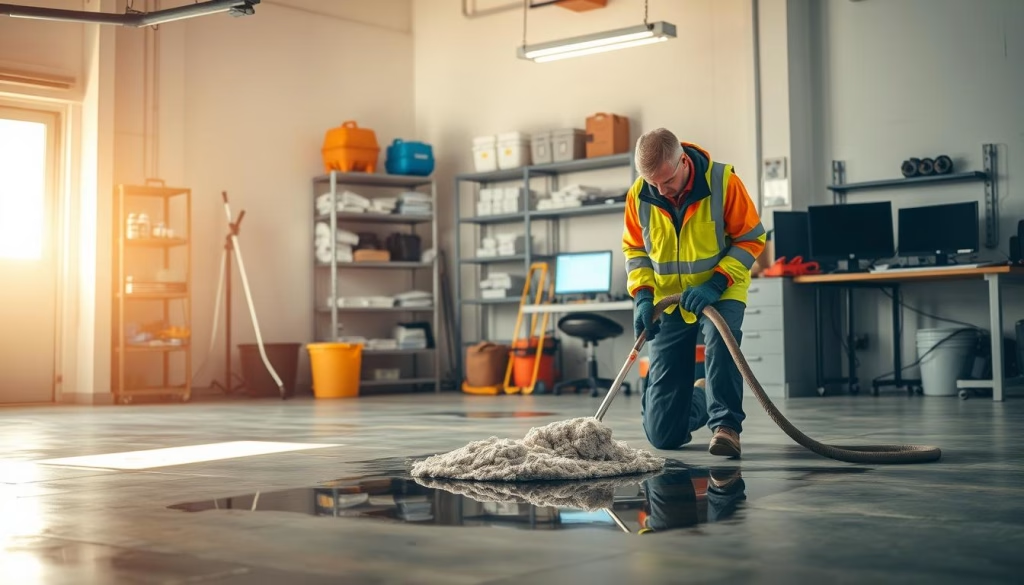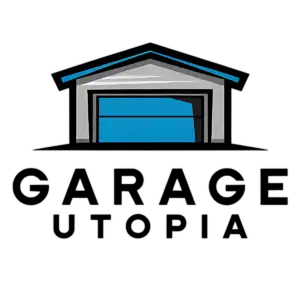Oil spills on garage floors can leave stubborn stains that look messy and pose slipping risks. Over time, these stains harden, making them harder to remove. This guide explains how to clean oil off concrete garage floor using proven methods. Whether from car leaks or spills, readers will learn practical solutions to remove oil stains from garage floor without damaging the surface.
Concrete’s porous surface traps oil, leading to permanent discoloration if ignored. Proper cleaning prevents long-term damage and restores safety. This article covers step-by-step techniques, product choices, and maintenance tips. Readers will discover both DIY strategies and when to consult professionals to effectively clean oil off concrete garage floor.
Understanding the Problem of Oil Stains on Concrete
Oil spills on concrete garage floors pose unique challenges. Concrete’s porous surface allows oil to seep deep into its structure, forming chemical bonds over time. This process makes oil spill cleanup on concrete far more complex than surface-level stains. Without prompt action, oil residues harden, creating stubborn stains that require specialized methods for effective oil stain removal from concrete.
Common sources include vehicle leaks like motor oil, transmission fluid, or brake fluid. These spills often occur during oil changes, equipment maintenance, or accidental drips. Over time, oil breaks down concrete’s surface, leading to discoloration and weakening structural integrity. The petroleum in oil reacts with concrete’s alkaline components, creating a bond that standard cleaners cannot dissolve.
Ignoring these stains risks more than aesthetics. Slippery surfaces increase fall hazards, while oil runoff can contaminate soil or water systems, violating environmental regulations. Immediate intervention halts chemical reactions, simplifying cleanup. Delayed treatment increases the risk of permanent damage, raising costs for both cleanup and future repairs.
Choosing the Right Cleaning Supplies
Effective oil removal starts with the right tools. Absorbent materials like cat litter, sawdust, or cornstarch are essential to soak up fresh spills. For set-in stains, stiff brushes or wire brushes scrub away residue. Always wear gloves, eye protection, and ensure good ventilation before starting.
Commercial degreasers like Simple Green or Krud Kutter work by breaking down oil bonds. Check labels for pH levels—alkaline cleaners suit heavy grease, while enzyme-based formulas target organic oils. Biodegradable options like Seventh Generation or Ecolab offer eco-friendly solutions safe for households with kids and pets.
Compare cleaning products based on stain age and severity. Newer spills may need less harsh chemicals, while old stains require stronger degreasers. Pair chosen products with absorbents to trap residue during the . Read manufacturer instructions for safety and application steps.
Before starting, gather a bucket, scrub brushes, and protective gear. Prioritize products rated for concrete to avoid surface damage. This checklist ensures you’re prepared for safe, effective cleanup.
Preparing Your Garage for Cleaning
Before starting garage floor oil spill cleanup, clear all items from the work area. Move vehicles, tools, and stored objects to avoid damaging belongings. Lay tarps over nearby walls or equipment to shield surfaces from cleaning solutions. Open all garage doors and windows for proper ventilation, ensuring safe airflow when using chemical products. Wear protective gear: chemical-resistant gloves, safety goggles, and a respirator mask when handling strong solvents.
Test cleaning agents on a small, hidden area first to check for discoloration or surface damage. Use plastic sheeting to contain runoff and prevent oil from spreading during scrubbing. Follow EPA guidelines for waste disposal—collect contaminated materials in sealed containers labeled as hazardous. Never pour oil-based residue down drains; contact local hazardous waste facilities for proper disposal instructions. These steps ensure oil stain removal techniques are executed safely and effectively without harming people or the environment.
Step-by-Step Guide to Remove Oil Stains
Start by absorbing fresh spills immediately. Spread cat litter or commercial absorbents like SpillFix over the stain. Let it sit for 1–2 hours to soak up oil. Sweep residue into a trash bag for proper disposal. For older stains, mix a solution of TSP (trisodium phosphate) with warm water. Apply it with a stiff brush, scrubbing in circular motions. Rinse thoroughly with a garden hose, ensuring no detergent remains.
For tough spots, use a pressure washer set to 1,500–2,000 PSI. Attach a 25-degree nozzle and keep the wand 12–18 inches from the surface. Sweep the nozzle side-to-side, avoiding direct impact on weak concrete. Test a small area first to prevent damage. If stains linger, try a degreaser like Simple Green, following label instructions. Let it sit 10–15 minutes before rinsing.
After cleaning, inspect the area. If stains persist, repeat steps with higher-strength solutions. Avoid using acids on calcium-rich concrete. Allow surfaces to dry completely between treatments. Always wear gloves and eye protection during all steps. Regular maintenance with absorbent pads after spills reduces long-term damage. Follow these methods to effectively clean oil off concrete garage floor while protecting your surface.
Natural Methods for Oil Stain Removal
Baking soda and vinegar form a powerful DIY oil stain removal duo. Mix equal parts of baking soda and vinegar to create a foaming paste. Apply it to fresh oil spots on garage floors and let it fizz. The acid in vinegar breaks down oils while the soda’s abrasiveness lifts residue. Scrub with a stiff brush after 15 minutes and rinse thoroughly.
Dish soap like Dawn works by emulsifying oil. Combine 1/4 cup Dawn with hot water in a spray bottle. Saturate old stains, let sit 10 minutes, then scrub. Rinse with hot water to flush soap and oil away. Repeat for stubborn areas.
Natural methods reduce chemical exposure and are eco-friendly. For deep-set stains, layer baking soda over the treated area and walk on it to grind it down. Wait overnight before sweeping and rinsing. These techniques are ideal for small or fresh spills but may require multiple sessions for older stains.
Test patches on concrete first to avoid damage. Natural solutions like these offer cost-effective remove oil stains from garage floor options but work best on lighter stains. Pair with proper rinsing for best results.
Addressing Different Types of Concrete
Concrete surfaces vary widely, and knowing your garage floor’s type ensures effective oil stain removal from concrete. Textured concrete holds oil in crevices, requiring scrubbing in specific directions to dislodge residue. Smooth surfaces may repel cleaners due to low porosity, so apply degreasers gently and work with a sponge for better absorption.
Older concrete often has porous surfaces where oil sinks deeper. Use stronger solvents cautiously to avoid damaging weakened material. Newer concrete, less porous but more chemically sensitive, needs milder techniques to prevent etching. Always test cleaners in a hidden area first.

Sealed concrete requires oil stain removal techniques that avoid stripping protective coatings. Use pH-neutral cleaners for epoxy or stained floors. Stamped concrete patterns may trap residue; target grooves with a soft brush. For unsealed surfaces, abrasive scrubbing works better but risks surface damage if overdone.
Check for existing coatings like acrylic sealants by applying water—beads indicate a sealed surface. Adjust cleaning strength based on age and texture. Prioritizing surface analysis ensures the right approach for lasting results without damaging your garage floor’s integrity.
Preventing Future Oil Stains
Maintaining a clean garage starts with proactive care. Regular sweeping and monthly degreasing using concrete floor degreasing methods stops buildup before it hardens. Quick action during spills reduces long-term damage, making oil spill cleanup on concrete faster and less costly.
Protective sealers like epoxy, acrylic, or silicate coatings create barriers against oil penetration. Epoxy offers heavy-duty durability for high-traffic areas, while acrylic provides a budget-friendly option. Polyurethane resists chemicals, and silicate sealers enhance concrete’s natural hardness. Research product reviews to match your garage’s needs and budget.
Install drip pans under vehicles and use absorbent mats in leak-prone zones. Regular vehicle checks under the hood and engine bay spot leaks early, reducing spill risks. Cardboard shields placed during maintenance catch drips before they reach the floor.
Professional sealers applied by experts ensure even coverage, but DIY kits work for smaller areas. Compare costs of annual resealing versus potential cleanup expenses to justify preventive measures. Small upfront investments in protection save time and money over years.
When to Call Professionals
Not all garage floor oil spills respond to home remedies. If stains persist after multiple DIY attempts, or cover large areas, hiring experts ensures the best way to clean oil off garage floor. Deeply embedded oil, especially in cracked concrete, may require industrial tools like high-pressure washers or chemical solvents beyond household use.

Professional crews use specialized methods such as thermal cleaning or diamond grinding to remove hardened residue. They also handle hazardous materials like transmission fluid, which demand proper disposal protocols homeowners might overlook. Assess the spill size—if larger than a car tire—professional intervention prevents further damage.
When selecting a service, verify certifications from organizations like the Institute of Inspection, Cleaning and Restoration Certification (IICRC). Ask for references and check if they provide guarantees against stain recurrence. Costs vary by square footage or labor hours, so request detailed quotes upfront.
Before their visit, clear the area of vehicles and debris. Professionals may apply absorbent pads first to soak up surface oil, then use rotary scrubbers to break down residue. This ensures the garage floor oil spill cleanup meets safety and aesthetic standards.
Final Touches and Maintenance Tips
After clean oil off concrete garage floor, inspect surfaces thoroughly. Check for oil residue by sprinkling water—if it beads, stains are gone. Use pH-neutral cleaners like Simple Green to neutralize leftover chemicals. Residual darkening can be treated with concrete brighteners such as Weiman or Rust-Oleum’s Revival. These products restore surface brightness without damaging concrete.
Maintain results with regular upkeep. Sweep weekly to remove debris and place absorbent mats near entry points. Schedule deep cleaning twice yearly using the best way to clean oil off garage floor methods outlined. Address new spills immediately with absorbent clay or cat litter to prevent seepage.
Extend protection by tackling other stains promptly. Rust spots respond to white vinegar soaks, while paint spills dissolve with mineral spirits. For long-term defense, apply a penetrating sealer like Thompson’s WaterSeal or Miracle Sealants’ Garage Floor Sealer. Reapply every 2–3 years depending on use.
Consistent care reduces future labor. Follow this regimen to keep floors clear of contaminants and extend intervals between major cleanings. Prioritizing maintenance ensures longevity and keeps your garage functional and presentable year-round.













